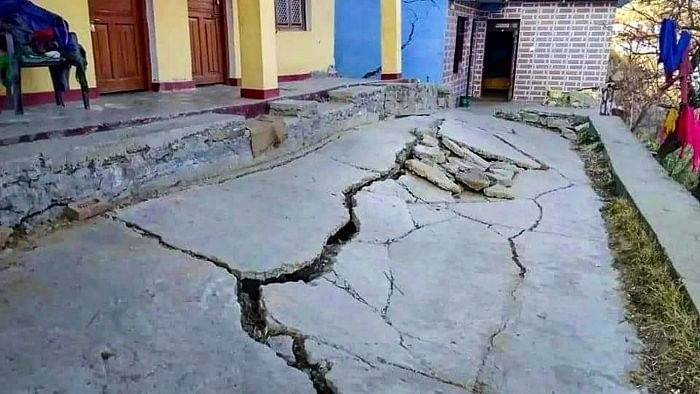
Starting January 2, a number of houses and civil structures in an area located near Joshimath-Auli road began to display major cracks due to land subsidence, prompting the relocation of 355 families.
Credit: PTI Photo
The absence of a building permit system is cited as one of the primary reasons for the extensive damage to houses in the subsidence-hit area of Joshimath in Uttarakhand, according to a post-disaster needs assessment conducted by government agencies.
Starting January 2, a number of houses and civil structures in an area located near Joshimath-Auli road began to display major cracks due to land subsidence, prompting the relocation of 355 families.
According to local residents, land subsidence had been noticed over several years but became increasingly severe from January 2 to January 8.
A 35-member team consisting of professionals from the National Disaster Management Authority, UN agencies, Central Building Research Institute, National Institute of Disaster Management, and other agencies conducted a 'Post Disaster Needs Assessment' from April 22 to April 25 to assess the damage caused and to identify the assistance required for the long-term recovery and reconstruction of the affected sectors.
The report highlights that although building bylaws exist, they are not mandatory for residential buildings.
'People obtain permits only when they need a loan or for other government requirements. One of the primary reasons for Joshimath's current situation is the absence of a building permit system. Had there been risk-based building bylaws in place and existing buildings were in compliance with them, the extent of damage would have been less, and retrofitting would have been less expensive,' the report said.
Another issue of concern identified in the report is the 'lack of town planning and absence of risk-informed land use maps'.
'The roads are too narrow, and there are hardly any open spaces in the neighborhoods. This makes the town highly unsafe since access in emergency situations is almost impossible,' it said, emphasising the urgent need for a comprehensive development plan.
The agencies emphasised the immediate need for the development of a prospective plan with the objective of creating a safe and resilient Joshimath for the next 10-15 years.
'The existing building bylaws need thorough examination to ensure that all multi-hazard issues, especially landslides and earthquakes, are addressed. There is a strong need for a simple pictorial version of the building bylaws and building regulations for the people and the masons. Compliance of buildings with multi-hazard safety norms requires awareness campaigns and a stronger people-government partnership,' they said.
According to a bulletin released by the district administration in April, 868 houses in Joshimath have been identified as having cracks, and 181 houses have been marked as unsafe for living.
Incidents of land subsidence in Joshimath were reported in the 1970s too. A panel set up under the chairmanship of Garhwal Commissioner Mahesh Chandra Mishra submitted a report in 1978, stating that major construction works should not be carried out in the city and the Niti and Mana valleys as these areas are situated on moraines — a mass of rocks, sediment, and soil transported and deposited by a glacier.
The Himalayan town lies in seismic zone V and is prone to landslides, flash floods, and earthquakes.
In 1999, an earthquake of 6.8 magnitude on the Richter scale shook Chamoli district, causing massive destruction in the district.
On February 7, 2021, severe flooding caused by heavy rainfall and a glacial burst in the nearby Rishi Ganga river ravaged Joshimath. The floodwaters also damaged two hydroelectric power plants located downstream from the Rishi Ganga river. The Tapovan Vishnugad hydroelectric power plant suffered the most damage, with many of its workers and staff missing or presumed dead.